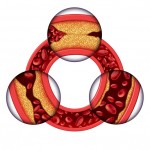
via SHUTTERSTOCK
HDL cholesterol is normally referred to as the good cholesterol, whereas LDL is known as bad. The role of these lipoproteins is to transport cholesterol to and from cells. The reason they have gained the reputation of good and bad is that LDL contributes to plaque buildup in arteries, and HDL has the role of scavenger, since it helps remove LDL from arteries and transport it back to the liver.
A recent report presented at the Study of Women s Health Across the Nation (SWAN) suggests a paradoxical role of HDL in women transitioning through menopause. There is a possibility that HDL is, in fact, proatherogenic meaning it has a tendency to form plaques.
The researchers divided study participants into premenopausal (early-perimenopausal) and late-perimenopausal (post-menopause). The results showed an inverse relationship of HDL in the premenopausal group, and a weaker or reversed relationship among postmenopausal participants. The study measured the degree of aortic calcification, coronary artery calcification, carotid plaque and intima media thickness (thickness of the inner walls of the blood vessel).
What this suggests, the researchers are stating, is the cardioprotective effects of HDL may become diminished as women transition through menopause.
Several studies before this study reported this paradoxical finding for the good cholesterol, mainly in postmenopausal and older women," states Dr. Samar El Khoudary of the University of Pittsburgh Graduate School of Public Health, Department of Epidemiology, the study s lead author. "However, none of these studies specifically point to menopause as being a possible reason for it. We used the SWAN to test whether menopause could be the reason for this paradoxical finding that others saw.
The authors of the paper state that there's sparse data on menopause-specific effects on lipoproteins. One of the explanations they offer for the observed difference has to do with the differing particle sizes of HDL.
A 2008 study published in the Journal of the American College of Cardiology found that very large HDL particles were associated with an increased risk of coronary artery disease (CAD). The authors were unsure of what the biological explanation of HDL becoming proatherogenic was, but they did mention that several studies have demonstrated that HDL can turn into a pro-inflammatory particle. In very high plasma concentrations large HDL particles may contribute to the paradoxical role of HDL.
The physiological basis for how menopause can affect the changes seen in lipoprotein profiles needs to be elucidated. There would be great value into future research in this area, as women are increasingly susceptible to CAD it is the number one killer of both men and women in the United States.
Studies have shown that women continue to be under-studied, under-diagnosed and under-treated.



